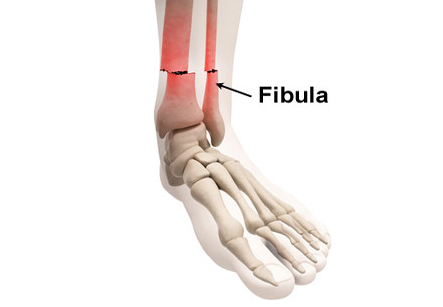Fibular Fracture
Introduction
Fibular fractures in the region involving the ankle and the shaft just proximal to it are common. They often result from trivial trauma. Initial management is often provided by primary care physicians and emergency clinicians.
The diagnosis and management of fibular fractures is important for treating this injury. Ankle fractures and sprains, stress fractures of the fibula, and fibula fractures in children are reviewed separately.
Fibular fractures in adults are typically due to trauma. Usually, the isolated fibular fractures comprise the majority of ankle fractures in older women. Fibular fractures may also occur as the result of repetitive loading and in this case they are referred to as stress fractures. Ankle fractures and sprains, stress fractures and fibular injuries are also common in children.
In adults, the key risk factor for fractures of the fibular or tibial shaft appears to be bone mass. Factors that reduce bone mass have greater impact than overall health status or other risk factors for falling. Cigarette smoking is another important risk factor for fibular fractures.
Iran ranks among the top 10 countries in orthopedics and Iranian surgeons perform high quality orthopedic surgeries at highly affordable prices

Athletes engaged in sports that are associated with contact or collision, have a higher incidence of fibular fractures. Typical examples of such sports include football, soccer, and rugby. Participants in downhill winter sports also have relatively high rates of fibular fractures. These are more common in snowboarding and skiing. Fracture patterns are different for each sport. Skiers often fracture the proximal third of the tibia and also the fibula. However, snowboarders are more likely to sustain isolated fractures of the distal end of the fibula.
Fracture of the Fibula Without Other Injury to the Ankle
Isolated fibular fractures, without affecting the integrity of the ankle joint, often can be treated with simple protection and immobilization. These injuries are known as a lateral malleolar fracture. They occur when the ankle twists or bends in an awkward manner, and the medial side of the ankle remains unaffected. In these situations, a brace is more than sufficient to support the ankle. Crutches are often used for a few days or weeks till the swelling and pain subsides. After pain has reduced, patients can begin rehabilitation to resume range of motion exercises, muscle strengthening and walking.
Fibula Fracture with Associated Ankle Injury
Fibula fractures associated with injury to inner side of the ankle, the medial malleolus or deltoid ligament, are serious fractures and often require more aggressive treatment. These fractures are known as bimalleolar ankle fractures. Definitive surgery is usually necessary to stabilize the ankle joint. Without surgery, the ankle joint may heal in abnormal alignment. This can lead to the development of early ankle arthritis.
Another type of injury that can occur with a fibular fracture is damage to the syndesmosis of the ankle. The syndesmosis means the group of ligaments that hold the two bones of the leg together. This is present just above the ankle joint. When the syndesmosis is damaged at the ankle, there is also possibility of associated fibula fracture. For this injury, surgery is often required to restore the alignment of the bones.
Fibula Fractures with Tibial Shaft Fractures
In severe injuries such as car crashes, sports injuries, or falls; there may be an injury of both tibia and the fibula above the ankle joint. These injuries usually require surgery to support the alignment of the leg and also the ankle joint. The fibula does not normally require a separate surgery to align the bone, if the fracture of tibia is repaired surgically. In some of these fractures, a long-leg cast (thigh to foot) is essential to provide necessary support without requiring the surgery.
In adults, the key risk factor for fractures of the fibular or tibial shaft appears to be bone mass.
The treatment of fibula fractures depends on a number of different factors such as the site of the suspected fracture, simple or compound injury and also other injuries which are associated with the fracture. Isolated fibula fractures usually heal quickly, but more serious and complex injuries may require further treatment. Therefore, it is very important to get these injuries evaluated by an experienced medical professional in the field of treatment of fibula fractures. This is for ensuring the institution of appropriate treatment.